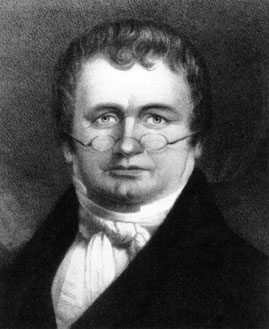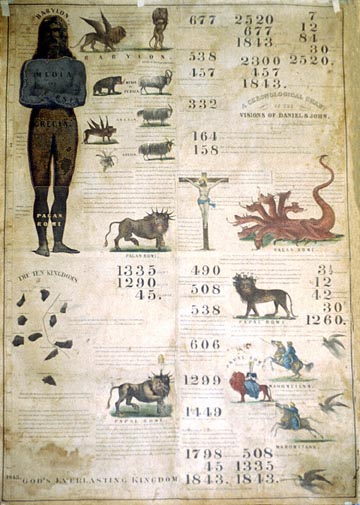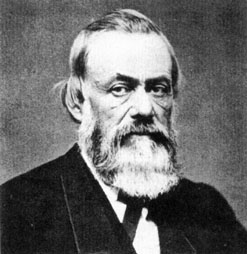The Founding of a Denomination: Miller and Himes, by Dr. David T. Arthur, Curator of the Jenks Collection, 1986-2005, and Professor Emeritus of History

1843 was to be the year of the world's end. In that year, Christ personally would return to the earth to establish his kingdom, glorify the saints, and take vengeance on the wicked. This was the conclusion arrived at by William Miller in 1822 and the message that he proclaimed for the next 21 years.
William Miller was born in Vermont and later became a resident of Low Hampton, NY. Following a period of years in which he proclaimed Deism, Miller was converted in 1816 and joined the Baptist Church of Low Hampton. Following his conversion, he was asked by Deist friends how he knew the Bible was true in light of seeming contradictions. According to his biographer Sylvester Bliss, Miller "was at first perplexed, but on reflection, he considered that if the Bible is a revelation of God, it must be consistent with itself; all its parts must harmonize, must have been given for man's instruction, and consequently, must be adapted to his understanding." He therefore determined to prove the Bible true by harmonizing all the apparent contradictions. If he failed in this, he told his friends, he would return to Deism.
William Miller thus began his careful study of the scriptures.
His study began and ended with the scriptures themselves. After two years, Miller concluded that the Bible was indeed truthful and that it was also its own interpreter. Even the symbolic portions of the scriptures could be clearly understood. A literal approach to and interpretation of scriptures became Miller's first and overriding principle of study and exposition.
Another of his principles reached during this period was the year-day theory of prophetic interpretation, which holds that when the time periods given in the books of the prophets are symbolic rather than literal, each day must be given a value of one year. A third conclusion to which Miller came was that if the student of the scriptures had enough faith, he would be led into the truth.
Armed with these principles, Miller proceeded in his study of the Bible for four more years. By 1822, he was ready to draw up a brief statement of his conclusions – a statement of faith. Miller had concluded that the scriptures plainly taught that Christ would descend personally and visibly to the earth a second time and that at his coming, dominion over heaven and earth would be given to him. The bodies of the righteous dead would be raised and the righteous living changed from a mortal to an immortal state, and both would meet the Lord in the air and reign with him on the regenerated earth. The only millennium taught in the scriptures was the thousand years that were to intervene between the first resurrection of the saints and the second resurrection of the wicked when the latter would be destroyed eternally. This accomplished, the Kingdom of God would come.

Miller further concluded that the Christian should not look for the restoration of the Jewish nation in Palestine prior to the second advent of Christ. The coming of Christ was the next event in prophetic chronology. Carrying the year-day theory to its conclusion, Miller stated that the scriptures taught not only that Christ's return was a near event to be continually expected, but that the prophetic books clearly taught the actual time when that event should be expected. And that time – the time of the end of the world – would come within 21 years, "on or before 1843."
For the next nine years, from 1822, William Miller's life followed its normal pattern, with no particularly outstanding events occurring. He discussed his views privately and individually, was listened to with interest, but found few who were willing to adopt them as their own. It was not until 1831 that he commenced his public ministry; in fact, until that year he had never seriously considered promulgating his views in any public way.
During the 1830s, Miller traveled and lectured with increasing frequency throughout New York and New England. He never went to a place without first being asked by a local congregation and securing the cooperation of the local minister. Wherever he went a revival followed his labors, sinners were converted and the luke-warm Christian revitalized. His reputation as an evangelist spread. Miller, not a formally educated man, did possess a good, if not subtle, mind. His knowledge of the scriptures was both extensive and detailed. He was obviously honest and sincere, and the people came to hear him. Miller's lectures were not of the more overwrought and emotional type. He preferred to arouse his hearers to become thoughtful students of the scripture, rather than simply to arouse their emotions.
The year 1838 witnessed a quickening of interest in Miller's message, probably in part the result of the economic depression. On the 12th of November, 1839, about 20 ministers of the Christian Church called in a body on Miller to question him concerning his views. One of the leaders of this group was Elder Joshua V. Himes, dynamic pastor of the Chardon Street Chapel in Boston. Himes was deeply impressed with Miller's message and the scriptural evidence, which he used to support his conclusions. He invited Miller to Boston to lecture sometime in December. Thus were brought together the two men, who in a short time would lead the forces sounding the "midnight cry." Within a year, the name of William Miller and the burden of his message were widely known across the northern and western United States, the result, in no small way of the unwearying efforts of J. V. Himes.
Dr. David T. Arthur, Curator (1986-2005)

Skilled in methods of promotion, Himes took Miller out of the rural areas and small towns and placed him in the great cities — the communication centers of the nation. Operating chiefly out of Boston and New York, Himes established strategic outposts in such places as Philadelphia, Cincinnati, and Rochester. Newspapers were established in each of the above cities, most notably "The Signs of the Times" (later " The Advent Herald") in Boston and " The Midnight Cry" (later "The Morning Watch") in New York. Books, pamphlets, tracts and other publications flowed from the presses in the thousands. Preaching and lecture tours for Miller and others were organized. Conferences, tent and camp meetings were employed to promote the cause and the message. Book depots and reading rooms were opened from Boston to St. Louis. J. V. Himes was the chief promoter, organizer and publicist of the Adventist cause—the man whom William Miller said did more than any other 10 persons to arouse the world to his message of warning and hope.
It is the wealth of material written in these early days and in the ensuing years that forms the core of the Jenks Collection of Adventual Materials at Aurora University.